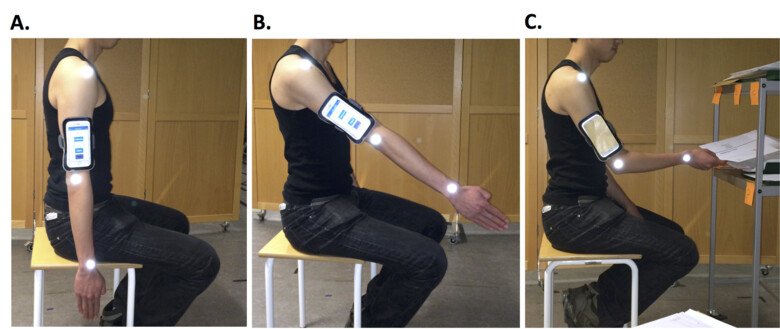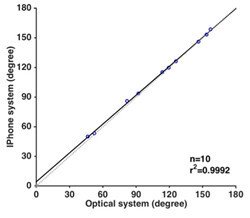ErgoArmMeter
ErgoArmMeter is a professional inclinometer application for measuring arm elevation during work. It is developed by Liyun Yang (KTH Royal Institute of Technology) under the supervision of Mikael Forsman (Karolinska Institutet). This project is a collaboration between Institute of Environmental Medicine at Karolinska Institutet (KI) and School of Technology and Health at KTH Royal Institute of Technology (KTH).
ErgoArmMeter – A novel iOS application for measuring arm inclination
It is shown by research that work with elevated arm may lead to shoulder/neck disorders. Ergonomists have been using inclinometers to measure arm elevation, which have a better precision than self-reports and observational methods. ErgoArmMeter is validated in an optical motion lab at KI and it has shown similar accuracy compared to other former validated inclinometers.


The validation experiments showed a high level of agreement between the two systems. In the static experiment (B, in the experiment-figure), the mean absolute difference between the optical system’s angles and those of the app was 1.5°.
In ergonomics practice, ErgoArmMeter would serve as a good alternative to other validated accelerometers. It has the advantage of low cost, easiness for use and directly obtained results. Also, due to the signal combination of the embedded gyroscope with accelerometer in the iPhone, it largely reduces the errors from the acceleration during fast movements. It can be used for evaluating the differences in arm inclinations between, e.g. two workstations, or before and after interventions. It can also be used for educational purpose. Together with other information about certain work task, it can add valuable information for risk assessments of the work task.
ErgoArmMeter has now been updated to version 2.0 and is free to download from the App Store. Generalized angular velocity is calculated and presented instead of inclination velocity. The generalized angular velocity is the time derivative of the distance traveled on the unit sphere, which can show the movements even on horizontal direction where inclination does not change. Recommended limits for safe work have been added to the result screen based on a report from the Center of Occupational and Environmental Medicine in Lund (Hansson et al., 2016).
Updates
ErgoArmMeter has now been updated to version 2.0 and is free to download from the App Store and Google Play Elisa Perini and Jitse Jan van Esch (master students from Sport Technology, KTH) have developed the updated Android version of ErgoArmMeter.
User manual
Related articles & reports
Yang, L., Grooten, W. J. A., & Forsman, M. (2017). An iPhone application for upper arm posture and movement measurements. Applied Ergonomics, 65, 492–500.
Yang, L. and Forsman, M., 2015. Development and validation of a novel iOS application for measuring arm inclination. Abstracts NES 2015. Lillehammer, Norway: Nordic Ergonomics Society.
Yang, L., 2015. Development and validation of a novel iOS application for measuring arm inclination. Master thesis, KTH Royal Institute of Technology. Available at: http://kth.diva-portal.org/smash/record.jsf?pid=diva2%3A852824&dswid=5654
Forsman, M., Dahlqvist, C., Yang, L., Wahlström, J., Hansson, G.-Å., 2015. Ny förenklad metod för heldagsmätningar av arbetsställningar och rörelser för huvud, nacke, rygg och överarmar - validitet och användbarhet [A new simplified method for whole-day measurements of postures and movements of head, neck, back and both upper arms - validity and usability]. Final project report to AFA Insurance. In Swedish with an English Abstract. Karolinska Institutet, Stockholm, Sverige.
